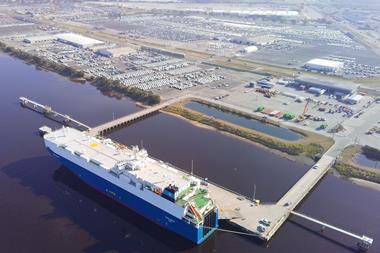The automotive supply chain has become more complex since Covid, demanding from carmakers a more cross-functional strategy supported by the latest digital technology. At Toyota Motor Europe (TME) it also means making its 2,000-strong supply chain team ambassadors for that strategy.
At last week’s Automotive Logistics and Supply Chain Digital Strategies conference in Germany, TME’s Jean-Christoph Deville, vice-president of supply chain, explained how the company was looking for radical breakthroughs on top of Toyota’s traditional strategy of incremental improvement.

Toyota’s supply chain experts have always had safety, quality, delivery and cost as priorities, according to Deville, but over the last few years those experts have had to react to supply chain challenges with resilience, agility and a new attention to sustainability. Deville said that over the last few years supply chain and logistics had become 400% more complex.
Not that it lacked complexity before. In production parts logistics TME moves 40,000 cu.m of parts a day. In terms of vehicle logistics it is responsible for moving one car every six seconds to the dealer network. It is also moving nine service parts per second to the retailers. The strong foundations of the Toyota Production System (TPS), built on the experienced problem solving and collaborative efforts of its team, continue to support those movements.
The team is also looking more intently at cutting carbon from the operations. Deville pointed to a recent example where TME has worked with VDL Groep on a hydrogen fuel cell truck, which it has been trialling. VDL will produce four more fuel cell trucks to be used by Toyota’s logistic providers: VOS Transport, Ceva Logistics, Groupe Cat and Yusen.
However, there is now also a greater need for data analytics and technological fluency, and crucially, better strategic thinking and leadership. Deville was keen to point out that at TME digitalisation and AI did not mean removing people from their jobs but using it as a complement to human intelligence.
“[It is a difficult thing] getting people to be sensitive in terms of data and technological fluency,” said Deville, “but more than this is how we come to the future with trust and believe we can make it happen as one team.”
Inspiring and motivating for success
According to Deville, Toyota needs to understand the trends of tomorrow and put together a list of actions to ensure it meets them. Key to achieving that is strong leadership.

“In simple terms that means two things,” said Deville. “How to inspire my people and [convey] a simple and clear understanding of where we should be going that they buy into. [It is also about] how to motivate them and ensure… we are great teams, and that we are going to succeed together.”
Deville explained that Toyota was struggling into a new world of digital technology and aiming to leave the world of green screens and Excel spreadsheets for a new one of cloud computing. That digital transformation is being driven by its long-established principle of continuous improvement (kaizen) but Deville said the company was now also looking for radical breakthroughs.
“We are not capable and not used to this,” he admitted. “The legacy of the organisation is about small steps and therefore it’s probably slower on innovation.”
To make the transition TME is intent on making its supply chain team members “ambassadors of the digital journey”. To this end it is organising regular workshops called Automation in One Day, where employees from across the supply chain sit down with IT coaches and look for processes to automate. That has been fruitful.
“In 2023 we have three waves of this,” said Deville. “We are doing them on a quarterly basis with 166 people involved. Together they have saved 651 days of low-added-value tasks that we can spend on more strategic thinking.”
Toyota is also organising hackathons, where supply chain employees interact with members of other business units, be it sales, insurance or finance, in a remote location for two or three days. There they try to solve problems affecting specific business areas. These sessions have also been fruitful, according to Deville, and in supply chain it is now using an AI container tool that has increased efficiency of container loading by 20% compared to previous methods.
“That would have taken ten years using the step-by-step, trial and error approach,” he said. “In a couple of days [employees] managed to put that data together, which was a very impressive achievement.”
Strategic collaboration
In terms of culturing better strategic thinking TME is doing two things. One is getting executives from across the company into the workshop or yard to directly observe and interact with what is going on in a particular operation, what Toyota calls genchi gembutsu. Executives learn about challenges that they had perhaps formerly had no idea of and then exchange opinions why those processes are in place and how they might be improved.
It is also building on its Corporate Obeya principle of getting people together to fix a problem. “The spirit is to listen to what others bring to the table in very pragmatic and problem-solving ways,” says Deville.

That sort of collective problem solving is also helping develop leadership. Leaders are encouraged to put processes together, focusing on how they work, and how they are inspiring and motivating their teams to follow them on the transformation of Toyota, “facing the future with trust and confidence”, said Deville.
Another approach TME is taking to improve leadership is ensuring that inspiration is discussed in terms of a concrete overall strategy. Leaders from different business units, such as IT and sales, and representatives from the dealer network, exchange ideas about the correct business strategy and how communication can be improved.
“Sometimes we try to confirm the strategy through exposure with the executives and they put a lot of time and effort into this, dedicated to coming and listening, and challenging the way we do business,” said Deville.
Ultimately, Toyota is looking for what Deville called “T-shaped people” – those who widen their understanding of internal and external processes and thinking, including the approach being taken by customers. That understanding is bound up with training, rotation between divisions, exposure to operations and cross-functional dialogue.
“If you don’t do that in this integrated world it is more difficult to have a good dialogue,” said Deville. “We are putting efforts into training and exposure, one to another. In that journey of talent we have more levels in the T-shaped dimension.”








































No comments yet